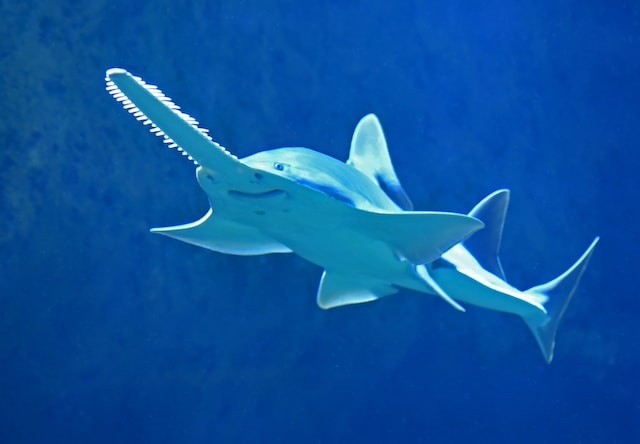The smalltooth sawfish (Pristis pectinata), the first native marine fish to be designated as threatened in 2003, has the unpleasant distinction of being the first.
Following decades of population decline brought on by habitat degradation, excessive fishing, and bycatch death in fisheries, the classification was made.
Smalltooth Sawfish in Cedar, Key Florida

Dean Grubbs, associate director of research at Florida State University's Coastal and Marine Laboratory and a member of the U.S. Coast Guard, co-taught the annual shark field course on June 6 where sawfish were caught, tagged, and released, as per Phys.Org.
Gavin Naylor, the leader of the Florida Museum of Natural History's shark research program, and the Smalltooth Sawfish Recovery Implementation Team.
In the past 30 to 40 years, the sawfish recovery team has not tagged an individual this far north, according to Naylor. It used to be usual to see sawfish throughout the Gulf and Atlantic Coasts. Sawfish are a form of elasmobranch, a group that includes sharks, skates, and rays.
Live young are born from the females, and they hunt and find refuge within the mangroves' sturdy, protecting roots. The long, flat-edged blade that was their most distinctive characteristic and recognized them as desirable possessions among trophy hunters.
Smalltooth sawfish populations decreased by more than 90% over the course of the 20th century, and scientists expressed skepticism about their capacity to bounce back rapidly, even with the help of protective measures.
The sawfish had scars from mating on its flanks and fins, which could be seen under scrutiny. There are few, if any, accounts of sawfish mating behaviors, however similarly related rays and sharks engage in wooing behavior whereby the males bite the female partners' fins prior to mating.
A small litter of seven to fourteen juveniles, that take several years to achieve reproductive age, are born by female smalltooth sawfish during their long life cycle.
Sawtooth populations have had a difficult time recovering because of their sluggish growth, but mating scars provide evidence that they are still increasing.
Naylor claims that the sawfish encounter was able to impart a lesson which would not have been feasible otherwise. There isn't a better approach for a group of young people doing environmental and conservation biology to discover more about this really magnificent and critically endangered animal.
Threats to its population
Red mangroves in particular serve as important nursery sites for young sawfish in shallow estuarine settings that are surrounded by vegetation, as per NOAA Fisheries.
A large portion of this habitat has been altered or lost as a result of waterfront development in Florida and other southeastern states. This could have an impact on locations where sawfish can reproduce and where young can survive.
Inshore gill nets in particular were notorious for mistakenly catching sawfish. Sawfish are generally destroyed rather than released unharmed because they have a chance of injure fishing equipment and represent a threat to fisherman.
Sawfish are still accidentally captured in a variety of fishing gears such as shrimp trawls, bottom longlines, and recreational hook-and-line gear, despite the fact that this threat has been significantly mitigated since the 1995 implementation of the Florida Net Ban Amendment.
Conservation of Smalltooth sawfish
On the federal endangered species list is the smalltooth sawfish. As a result of overfishing and entanglement in fishing gear, sawfish populations are probably on the decline. This is because of how easily their long, toothed rostrums may tangle in nets and fishing line, as per The National Wildlife Federation.
Some tribes dry the saws out and sell them as ornaments. Further contributing to the reduction of sawfish is the destruction of mangrove forests and other nursery habitats in the Southeast for the construction of beachfront homes.
To help fisherman release erroneously caught sawfish safely, recovery activities are already underway. Sawfish populations have declined, but this reduction has been slowed by the creation of marine protected zones and the outlawing of entangler fishing gear in Florida waters.
Related Article : Bizarre Looking Sawfish IN CRITICAL Danger: Can They Still be Saved?
© 2025 NatureWorldNews.com All rights reserved. Do not reproduce without permission.





